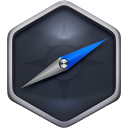Using npm to globally install GUI-based applications based on nw.js
 The “ npm install ” command in the npm
The “ npm install ” command in the npm However, it is possible to run this command
This common place, according to the documentation , under Windows is the
')
Usually this approach is used for global installation of various utilities designed to be run from the command line. Here are some examples:
- The
“ npm install jshint -g ”command provides the appearanceof the “jshint” command in the PATH, which serves to launch JSHint . - The
“ npm install browserify -g ”command provides the appearanceof the “browserify” command in the PATH, which serves to launch Browserify . - The
“ npm install less -g ”command ensures the appearanceof the “lessc” command in PATH, which serves to start Less.js.
 However, on the CLI (on the command line) the light did not come together - and Habrahabr readers should be completely aware that a JavaScript application using the Node.js API can also be equipped with a GUI (graphical user interface) written in HTML and CSS . To do this, you will have to launch such an application instead of Node on that engine, which until last year was called node-webkit , and this year (2015) turned out to be renamed
However, on the CLI (on the command line) the light did not come together - and Habrahabr readers should be completely aware that a JavaScript application using the Node.js API can also be equipped with a GUI (graphical user interface) written in HTML and CSS . To do this, you will have to launch such an application instead of Node on that engine, which until last year was called node-webkit , and this year (2015) turned out to be renamed Your
Your first step is clear: you will certainly need to put the source code of your
However, to run this code, you will also need
To overcome this problem, the developers created
It should be noted also that the nw package (in
But it is immediately apparent that this is not the most convenient way to launch a
For example, I’ll point out that, as part of my browser of hypertext vector Fidonet, the open source code of such a script looks like this :
#!/usr/bin/env node require('child_process').spawn( require('nw').findpath(), ['.'].concat( process.argv.slice(2) ), { cwd: __dirname, detached: true, stdio: 'ignore' } ).unref(); It is not difficult to see that there is absolutely nothing specifically Fidonet's in it. Therefore, you can use the same example without any changes in your own
Be sure to pay attention to the following fragments of this example:
- “ Detached: true ”
and “ .unref () ”: the nw.js engine starts as a separate process, and the start command ends its work immediately (does not wait for it); “ Cwd: __dirname ”: the nw.js engine starts in the directory where npm globally installed the start command (assuming that the entireGUI application is in the same place; but if this code was not put next to the package file .json , as I did, and in some subdirectory, add the output from the subdirectory to the parent directory in this line);“ ['.']. Concat (process.argv.slice (2)) ”: the nw.js engine in the command line first sends a point (an instruction to take the application being started from the current directory), and then all the command line parameters of the start command;“ #! / Usr / bin / env node ”: under Windows, this line may not seem necessary, but this impression is illusory (in fact, npm relies on the presence of this line).
The above approach can also be applied to the installation of applications,
Source: https://habr.com/ru/post/252029/
All Articles